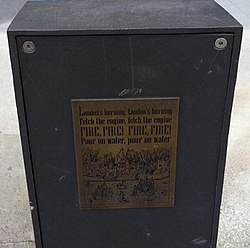
"Scotland's Burning", also known in England as "London's Burning", is a variant of a song and nursery rhyme popular with children.

"Scotland's Burning", also known in England as "London's Burning", is a variant of a song and nursery rhyme popular with children.
The song can be sung as a round when each part starts two bars after the previous one. It may be an example of a nursery rhyme with tragic or violent themes. The London lyrics are said to be about the Great Fire of London, a five-day fire in the city of London in 1666. [1] The first notation of a round in this theme dates from 1580. [2] The Scotland lyrics are said to be about the Burning of Edinburgh in 1544, ordered by Henry VIII of England. [3]
The lyrics are alluded to in William Shakespeare's The Taming of the Shrew , Act 4, scene 1, when Grumio asks Curtis to prepare a warm fire for guests. [4]
In the Netherlands the song is known as "Brand in Mokum " ("Fire in Amsterdam") [5] [ circular reference ], which is said to refer to the Amsterdam revolt against Napoleon in 1813. [3]